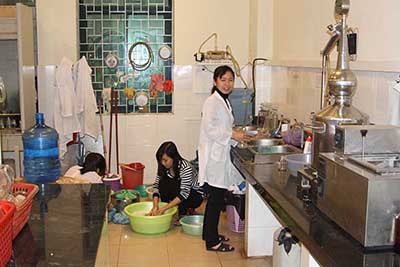
FAYETTEVILLE, Ark. – Steve Stephenson, a visiting professor in the Department of Biological Sciences in the J. William Fulbright College of Arts and Sciences, traveled to Vietnam on a Fulbright Specialist Award in March 2014.
Stephenson shared findings from his work with a group of organisms called myxomycetes, also known as slime molds, with faculty members and students at Hanoi National University of Education, one of the largest universities in the country. His stay also included a presentation at the Vietnam Institute of Educational Sciences and visits to two national parks.
Stephenson spent two weeks in Vietnam presenting seminars, holding workshops and developing potential collaborative research opportunities. Whereas other awards within the Fulbright Program may last several months or even years, the Fulbright Specialist Program grants are designed for short-term, collaborative projects. These shorter exchanges give specialists greater flexibility to pursue projects that work best within the context of their current academic or professional commitments.
 Administration Building at Hanoi National University of Education. Administration Building at Hanoi National University of Education. |
 Faculty and graduate students at Stephenson’s lecture on scientific writing. Faculty and graduate students at Stephenson’s lecture on scientific writing. |
 Graduate students in a biochemistry laboratory at Hanoi National University of Education. Graduate students in a biochemistry laboratory at Hanoi National University of Education. |
Project requests are submitted by non-U.S. institutions and focus on strengthening and supporting institutions’ development needs and are awarded to U.S. faculty and professionals approved to join the specialist roster in select disciplines at eligible institutions in more than 140 countries worldwide. The Hanoi National University of Education formally requested Stephenson’s visit because education regarding myxomycetes is limited in the area. Only one other person, Hanh Thi My Tran, had been known to work with the organisms in Vietnam.
Stephenson served as external director for a portion of Hanh’s graduate studies who studied at the University of Arkansas three years ago as a Senior Fulbright Scholar. Hanh has returned to the university for the 2014-15 academic year on an International Fellowship from the American Association of University Women.
While at Hanoi National University, Stephenson presented a series of seminars to graduate and undergraduate students on global patterns of biodiversity, high-latitude ecosystems, the ecology of tropical forests and mycology. He also gave a workshop to faculty members on scientific writing as it relates to grant proposals and papers for publication and met with individual faculty members and graduate students to discuss and review their manuscripts and grant proposals.
Few of the students understood English, but all were motivated to learn as much as possible about scientific writing. Learning from an American professor is rare for these faculty and students, and most had never been taught the fundamentals of academic writing.
Stephenson has traveled to many countries throughout his career, including several other parts of Asia, but he found North Vietnam to be very different from any of the other cultures that he has experienced.
“I’ve seen a strong American influence in most of my travels, but it wasn’t readily apparent in Hanoi,” Stephenson said.
During his visit, he also observed several limitations to the research carried out by students and faculty members including inadequate laboratory and classroom equipment, insufficient safety procedures in the labs and a minimal understanding of English. The Hanoi National University is making an effort to increase fluency in English among students to improve their potential scientific contributions. As Stephenson states, “English is the language of science.”
During his stay, Stephenson was invited to make a special presentation to personnel at the Vietnam Institute of Educational Sciences, also located in the city of Hanoi, about the details involved in writing successful grant proposals. The institute is the country’s largest educational research organization.
Stephenson also visited two national parks in North Vietnam to observe first-hand conservation efforts in the country and discuss possible collaborative research opportunities. He is currently pursuing steps to create a memorandum of understanding between the University of Arkansas and Hanoi National University of Education to enhance the exchange of information and collaborative research between the two institutions.
This is Stephenson’s second Fulbright experience. He spent a semester as a Senior Fulbright Scholar at Himachal Pradesh University in India in 1987. For this trip, he was accompanied to Vietnam by his wife, Barbara, who is an instructor in the Department of Mathematical Sciences at the University of Arkansas.
The Fulbright Exchange Program was established in 1946. Today, 51 binational commissions join the United States in underwriting a program that operates in more than 155 countries worldwide and has provided approximately 310,000 participants with the opportunity to study, teach or conduct research in each others' countries and exchange ideas. In 1982, the University of Arkansas formally dedicated the Fulbright College of Arts and Sciences in recognition of Fulbright’s contributions toward international understanding and education.
Contacts
Steve Stephenson, visiting professor
Department of Biological Sciences
479-575-2869, slsteph@uark.edu
Taylor Glover, communications intern
J. William Fulbright College of Arts and Sciences
479-575-3712, tglover@uark.edu